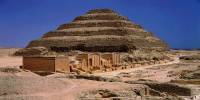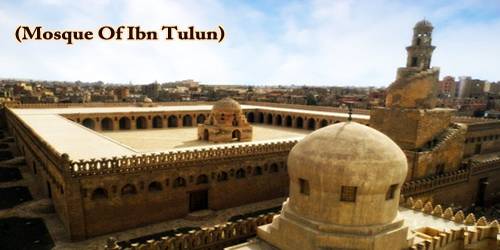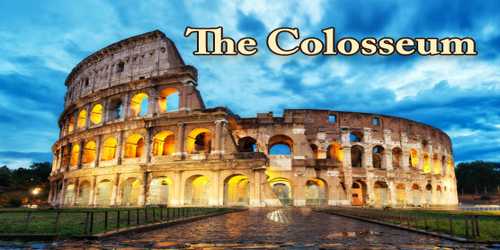The Acropolis of Athens is one of the most famous ancient archaeological sites in the world. It is an ancient citadel located on a rocky outcrop above the city of Athens and contains the remains of several ancient buildings of great architectural and historic significance, the most famous being the Parthenon. The word acropolis is from the Greek words ἄκρον (akron, “highest point, extremity”) and πόλις (polis, “city”). Although the term acropolis is generic and there are many other acropoleis in Greece, the significance of the Acropolis of Athens is such that it is commonly known as “The Acropolis” without qualification. During ancient times it was known also more properly as Cecropia, after the legendary serpent-man, Cecrops, the supposed first Athenian king.
The Acropolis is the heart of the city of Athens. It is a steep limestone crag (156m above sea level) where, during the Pisistratid era, in the second half of the VIth century BC, the first religious buildings were raised.

(The Acropolis listed as world heritage by UNESCO)
Over the centuries, the Acropolis was many things: a home to kings, a citadel, a mythical home of the gods, a religious center and a tourist attraction. It has withstood bombardment, massive earthquakes and vandalism yet still stands as a reminder of the rich history of Greece. Today, it is a cultural UNESCO World Heritage site and home to several temples, the most famous of which is the Parthenon.
While there is evidence that the hill was inhabited as far back as the fourth millennium BC, it was Pericles (c. 495-429 BC) in the fifth century BC who coordinated the construction of the site’s most important present remains including the Parthenon, the Propylaia, the Erechtheion and the Temple of Athena Nike. The Parthenon and the other buildings were seriously damaged during the 1687 siege by the Venetians during the Morean War when gunpowder being stored in the Parthenon was hit by a cannonball and exploded.
Made of limestone rock that dates to the Late Cretaceous period when dinosaurs still roamed the earth, the Acropolis is located on the Attica plateau of Greece and includes four hills:
- Likavitos Hill
- Hill of the Nymphs
- The Pynx Hill
- Philapappos Hill
Athens has the best-known acropolis, built during the second half of the 5th century BC. The Athenian acropolis, located on a craggy, walled hill, was built as a home of Athena, the patron goddess of the city. The structures that survive consist of the Propylaea, the gateway to the sacred precinct; the Parthenon, the chief shrine to Athena and also the treasury of the Delian League; the Erechtheum, a shrine to the agricultural deities, especially Erichthonius; and the Temple of Athena Nike, an architectural symbol of the harmony with which the Dorian and Ionian peoples lived under the government of Athens.
The Acropolis flat top is the result of thousands of years of construction beginning as far back as the Bronze Age. There’s no recorded history of what happened at the Acropolis before the Mycenaeans cultivated it during the end of the Bronze Age. Historians believe the Mycenaeans built a massive compound surrounded by a great wall (almost 15 feet thick and 20 feet high) on top of the Acropolis to house the local ruler and his household.
The Acropolis is located on a flattish-topped rock that rises 150 m (490 ft) above sea level in the city of Athens, with a surface area of about 3 hectares (7.4 acres). While the earliest artifacts date to the Middle Neolithic era, there have been documented habitations in Attica from the Early Neolithic period (6th millennium BC).
Years later, the Athenians built a Doric temple made of limestone, known as Bluebeard Temple, on the northeast side of the hill in honor of the goddess Athena in the sixth century B.C. It was named after a sculpture that adorned the building that depicted a man-serpent with three blue beards. Another temple dedicated to the Athena was also erected in the same century, as was a shrine to Artemis Brauronia, the goddess of expectant mothers in Greek mythology.
Situated in the center of ancient Athens, the Acropolis is a hill containing ancient monuments and fortifications.
At its extreme points, it is 270 meters (885 feet) long and about 156 meters (512 feet) wide, writes University of Oregon researcher Jeffrey Hurwit in his book, “The Acropolis in the Age of Pericles” (Cambridge University Press, 2004). He notes that although it is not the highest hill in Athens, its natural defenses, access to water and a summit that you can build on made the ancient Athenians decide to build some of their greatest monuments on top of it.
During the Greek Dark Ages (800 B.C. to 480. B.C.), the Acropolis remained largely intact. Many religious festivals were held there, and the artifacts of the time reflected the grandeur of ancient Athens.
Around 490 B.C., the Athenians started building a majestic marble temple known as the Old Parthenon. By that time, the Bluebeard Temple had been demolished by the Persians.
In 480 B.C., the Persians attacked again and burned, leveled and looted the Old Parthenon and almost every other structure at the Acropolis. To prevent further losses, the Athenians buried the remaining sculptures inside natural caves and built two new fortifications, one of the rock’s north side and one on its south.
There are different translations of its name, but the word Acropolis basically means “high city.”
“Almost every Greek city-state (or polis) had one, but no other acropolis was as successful as the Athenian,” Hurwit writes. The structure was always visible and “at various times throughout its uninterrupted 6,000 year-long cultural history served as dwelling place, fortress, sanctuary and symbol often all at once.”
The Acropolis was reconsecrated and rebuilt from 448 BC onwards, after the signing of the treaty of peace between Athens and the Persians (the “Peace of Kallias”, which was actually negotiated by Perikles).
The entrance to the Acropolis was a monumental gateway termed the Propylaea. To the south of the entrance is the tiny Temple of Athena Nike. At the centre of the Acropolis is the Parthenon or Temple of Athena Parthenos (Athena the Virgin). East of the entrance and north of the Parthenon is the temple known as the Erechtheum. South of the platform that forms the top of the Acropolis there are also the remains of the ancient, though often remodelled, Theatre of Dionysus. A few hundred metres away, there is the now partially reconstructed Odeon of Herodes Atticus.
All the valuable ancient artifacts are situated in the Acropolis Museum, which resides on the southern slope of the same rock, 280 metres from the Parthenon.
The UNESCO site claims:
“The Athenian Acropolis is the supreme expression of the adaptation of architecture to a natural site. This grand composition of perfectly balanced massive structures creates a monumental landscape of unique beauty consisting of a complete series of masterpieces of the 5th century BC. The monuments of the Acropolis have exerted an exceptional influence, not only in Graeco-Roman antiquity, a time when in the Mediterranean world they were considered exemplary models, but in contemporary times as well.”
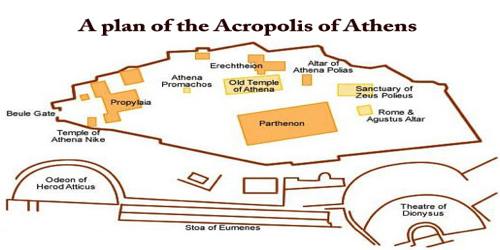
The Acropolis rises 490 feet (150 metres) into the sky above the city of Athens and has a surface area of approximately 7 acres (3 hectares). The site was a natural choice for a fortification and was inhabited at least as early as the Mycenaean Period in Greece (1900-1100 BCE) if not earlier. There was already a complex built on the hill, and a temple to Athena in progress, which was destroyed by the Persians under Xerxes in 480 BCE when they sacked Athens. The later structures, famous today, were built as a testament to the resilience of the Athenians following the defeat of Xerxes’ forces at the Battle of Salamis (480 BCE) and to exemplify the glory of the city.
Every four years, the Athenians had a festival called the Great Panathenaea that rivaled the Olympic Games in popularity. During the festival, a procession (believed to be depicted on the Parthenon frieze) traveled through the city via the Panathenaic Way and culminated on the Acropolis. There, a new robe of woven wool (peplos) was placed on either the statue of Athena Polias in the Erechtheum (during the annual Lesser Panathenaea) or on the statue of Athena Parthenos in the Parthenon (during the Great Panathenaea, held every four years).
Within the later tradition of Western Civilization and classical revival, the Acropolis, from at least the mid-18th century on, has often been invoked as a key symbol of the Greek legacy and of the glories of Classical Greece.
If the Acropolis was impressive during the Mycenaean Civilization, it was nothing short of spectacular during the Golden Age of Athens (460 B.C. to 430 B.C.) under the rule of Pericles when Athens was at its cultural peak. Pericles didn’t live long enough to see his entire Acropolis vision come true, but temple builders and architects continued working until they completed the project. The southern and northern walls were rebuilt and some of the most iconic structures in the world were constructed such as:
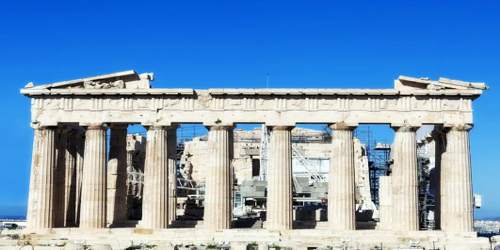
(The Parthenon in Athens)
The Parthenon: An enormous Doric-style temple that remains the star attraction of the Acropolis. It featured ornate sculptures and housed a spectacular statue of the goddess Athena.
The Propylaea: A monumental entryway to the Acropolis that included a central building and two wings, one of which was covered with elaborately painted panels.
The Temple of Athena Nike: A small Ionic-style temple located to the right of the Propylaea built as a shrine to Athena Nike.
The Erechtheion: A sacred Ionic temple made of marble which honored Athena and several other gods and heroes. It’s best known for its porch supported by six Caryatid maiden statues.
The Statue of Athena Promachos: A gigantic (almost 30 feet tall) bronze statue of Athena that stood next to the Propylaea.
The Acropolis saw few changes after Sparta won the Peloponnesian War, although a minor temple honoring Caesar Augustus and Rome was built in 27 B.C.
After the Ottoman conquest of Greece, the Parthenon was used as the garrison headquarters of the Turkish army, and the Erechtheum was turned into the Governor’s private Harem. The buildings of the Acropolis suffered significant damage during the 1687 siege by the Venetians in the Morean War. The Parthenon, which was being used as a gunpowder magazine, was hit by artillery shot and damaged severely.
Following the War of Independence of 1821 CE, the Greeks reclaimed the Acropolis and attempted to restore it to its former glory. The English Lord Elgin, however, with the Turks approval, had “removed a number of the pedimental figures and large chunks of the frieze of the Parthenon, and sold them to the British Museum in 1816” (Pedley, 263). Further, the damage to much of the Acropolis, after years of occupation and neglect, seemed irreparable. Only in the latter part of the 20th century CE was serious restoration and preservation work initiated on the Acropolis site. Such work is ongoing in the present day including a new museum which houses significant artefacts from the site.
Today, in the 21st century, a new group of people is making a mark on the Acropolis. Conservators, engineers, architects and other scientists are working together at conserving and restoring the structures on it, part of a project that has been going on for 35 years.
The Acropolis is open to tourists year-round and is located in a busy area of the city of Athens. Tickets are available at the entrance, but be prepared to wait. To miss the crowds and the summer heat, arrive early in the morning or after 5:00 p.m.
Most importantly, bring comfortable shoes and water because exploring the Acropolis requires a lot of walking. Keep in mind that some buildings may be inaccessible due to renovations.
Information Sources:

